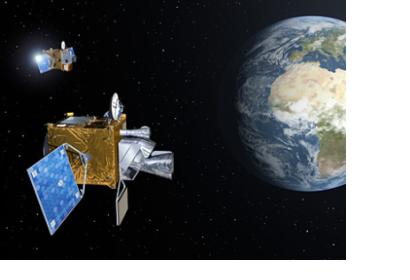Europe’s next fleet of meteorological satellites is set to debut in 2017, following today’s signing of the development contract. While Meteosat Third Generation will ensure full continuity with the current Meteosat satellite family, it will also introduce significant improvements. At an event held today at ESA’s headquarters in Paris, the contract between ESA and Thales Alenia Space for developing the new Meteosat Third Generation (MTG) family of satellites was signed. Following on from Meteosat Second Generation, MTG is a cooperative venture between Eumetsat and ESA, and will ensure continuity of high-resolution meteorological data to beyond 2037. The cooperation on meteorological missions between Eumetsat and ESA is a success story that started with the first Meteosat satellite in 1977 and continues today with Meteosat Second Generation and the polar-orbiting MetOp series.
The new series will comprise six satellites: four MTG-I imaging and two MTG-S sounding satellites. The first two prototype satellites are scheduled for launch in late 2017 and mid-2019, respectively. Both satellites will be positioned in geostationary orbit above the equator at a longitude between 10ºE and 10ºW. In addition to the advanced imaging capabilities offered by the Flexible Combined Imager, the satellites will offer an all-new infrared sounding capability and imaging of global lightning that will provide early warning of severe storms. MTG-S will also carry the Sentinel-4 payload for the Global Monitoring for Environment and Security (GMES) programme. This advanced payload will analyse atmospheric chemistry and identify concentrations of trace gases like ozone and nitrogen dioxide. The MTG mission will also provide continued support to global search and rescue monitoring, as well as supporting the Advanced Data Collection System.
At Friday’s event, ESA Director General Jean Jacques Dordain highlighted that Europe can today – and now well into the future – offer state-of-the-art meteorological global monitoring thanks to the 25-year collaboration between ESA and Eumetsat. Mr Dordain recalled the launch of Meteosat-1 35 years ago, and praised the commitment of ESA, Eumetsat and all industrial partners to continuing the Meteosat legacy. ESA’s Director of Earth Observation Programmes, Volker Liebig, looked ahead to the significant improvements in performance from the new satellites. In these difficult economic times, Prof. Liebig stressed, the programme offers many opportunities for European industrial companies to win substantial and high-technology contracts. The MTG contract has an industrial value of over €1.25 billion.
Speeches were also made by Eumetsat Director General Alain Ratier and Thales Alenia Space CEO Reynald Seznec. The contract between ESA and Thales Alenia Space was signed by Mr. Liebig and Mr Seznec. Thales Alenia Space leads the industrial consortium that now building the MTG family. Along with being the prime contractor, Thales Alenia Space is responsible for the MTG-I imaging satellite, including the primary payload, the Flexible Combined Imager. Bremen-based OHB is responsible for the MTG-S satellites and provision of the common satellite platforms, supported by Astrium GmbH as the System Architect. The state-of-the-art Infrared Sounding Instrument, to be flown on MTG-S, will be developed by Kayser Threde.

